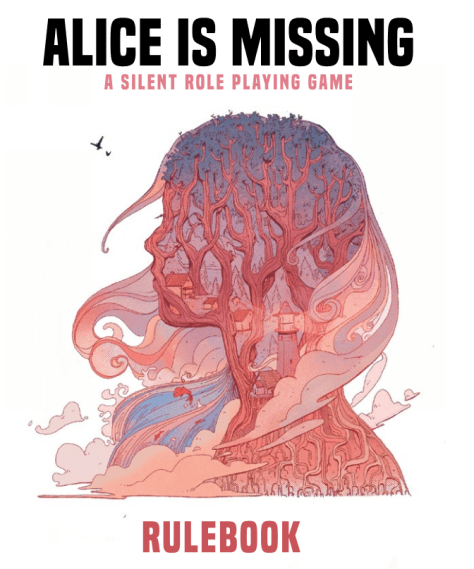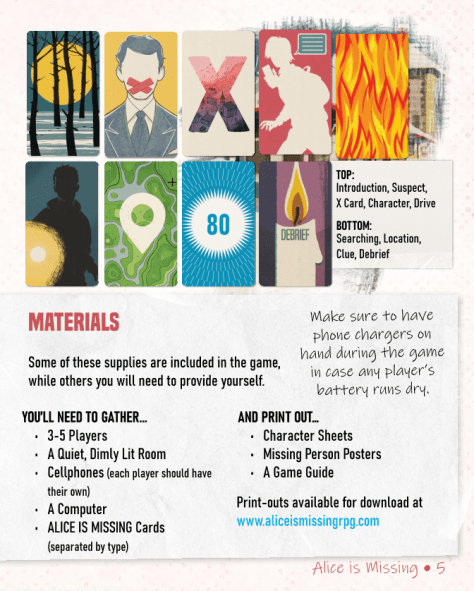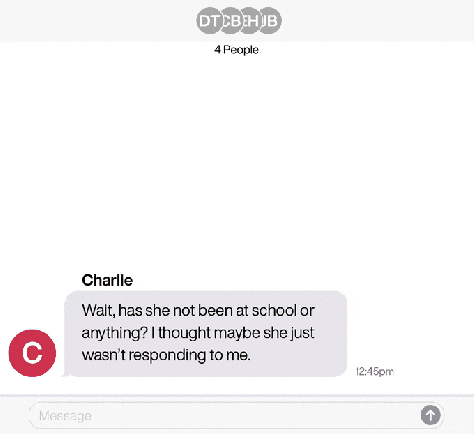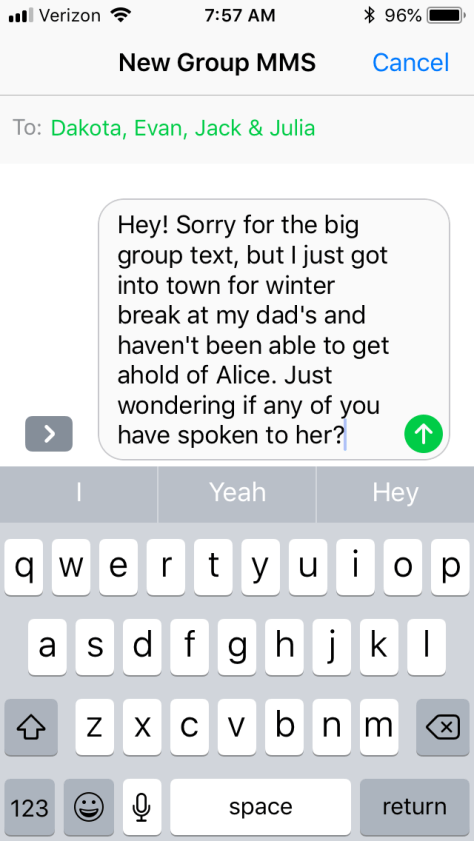Silent Falls is a small coastal town in the heart of Northern California. It’s quiet here, and since the recession a few years ago, people are not as friendly as they used to be. It’s been a rough few years for everyone. Alice Briarwood is a junior at Franklin Academy – the local high school – with a pretty decent number of acquaintances and friends, but as dawn rises on the first morning of winter break, nobody has seen or heard from Alice in three days. A friend returns to Silent Falls and reaches out, wondering at Alice’s silence, sparking off an effort by her loved ones to find her. However, this is no normal storytelling game; during play, you won’t say a word. Instead, as characters scatter across Silent Falls to find Alice, a text group chat will be the only way to tell your tale. This is Alice is Missing – A Silent Roleplaying Game.

Designed by Spenser Starke and brought to us by Hunters Entertainment on the digital side and Renegade Games Studios on the physical side ( a collection of names that brings to mind games like Kids on Bikes, Kids on Brooms, Icarus, and Overlight), Alice is Missing is a suspense-filled one-shot style mystery roleplaying game for 3-5 players. Over the course of the game players will investigate Alice’s disappearance and follow clues in an effort to find her, sharing hunches, suspicions, and secrets among one another as they try and figure out what happened and where she is.
However, while you’ll be talking out loud during the setup and after the game, actual play is non-verbal: this game is played entirely via text messages.
Before we get into things, though, hit play on this video. Don’t worry about the countdown, we’ll get to that later, but it’ll help with the mood – just like it will during actual play.
Setting Up

So, once you’ve gathered the above items and persons, it’s time to start getting ready to play the game, a setup period that the game estimates to take about 45 minutes. One player is also the Facilitator, who is responsible for reading out the Game Guide (a kind of cheat sheet about the game and its flow), explaining the rules, prompting the others when necessary, and playing the character that starts off the game.
AiM spends a healthy number of words on player safety. Lines (content which is a hard no), veils (content that can be mentioned but shouldn’t be described in detail), and the X-Card (the hard no button for when something comes up mid-game) are discussed. Alice is Missing is a game about a missing teenage girl, a story that can be found all too often in the real world, and the game does a lot to make sure players are comfortable and the game is respectful. If players have to leave, they can, and while characters might find themselves upset at Alice she should never be blamed for what’s happened/happening to her.
Each player picks a character; the Facilitator always plays Charlie Barnes, a friend of Alice’s who moved out of town a few years ago and is returning to visit their father, unaware that the reason Alice hasn’t responded to messages for a few days is because she’s missing. Then there’s Jack Briarwood (the older brother), Dakota Travis (the best friend), Evan Holwell (the one with the crush), and Julia North (the secret girlfriend). Each has a background, which should be discussed during setup; Jack tells the group why he and Alice’s home life has been so difficult the last few years, while Julia talks about how they and Alice first met. They each also have a secret, however, that each player keeps to themselves for now; Dakota snuck out with Alice to do something they weren’t supposed to the night before Alice vanished, while Evan promised to hide something for Alice and is now worried that revealing it will make them a suspect. It’s up to the players to determine the exact nature of their secret.
Each player also draws a Drive card, which adds a Motive to their character such as wanting to find someone to blame for Alice’s disappearance or trying to keep everyone calm and bury your own fear. The Drive cards also provide two relationship prompts, another item to be discussed among the group during setup, for you to relate with other characters: you might have never gotten along with another character, or you might be protective of them, or perhaps they know a secret about you.
After relationships are assigned, players exchange phone numbers (labeling their contacts with the name of the characters), and the Facilitator sets up the group chat. The Facilitator then opens up a voice recording app, leaves the room, and records a ‘voicemail’: the last message Charlie left Alice before finding out that she’s missing. Each other player then takes turns doing the same thing, prompted by their character cards; these voicemails will come up much later. The Facilitator then opens up that video up above, pausing it once it loads, as it will serve as both a timer and the soundtrack.
The last steps are distributing Clue Cards and talking about your hunches. Charlie gets the 90 minute card. while a 10 minute card is picked randomly and placed face down on the table. For each other group of Clue Cards – broken out by time, from 80 minutes to 20 – a single card is picked and handed out to a player until all of the time slots are accounted for, making sure no player has back-to-back cards chronologically speaking (having a different number of cards, however, is okay). Then the group will take a look at the Suspect and Location cards, with each player taking turns choosing one and and detailing why they’re suspicious in relation to Alice’s disappearance, writing down notes. With that done, the cards in question get shuffled back into their decks, the Searching Cards are placed within easy reach, and everyone gets comfortable.
It’s Saturday, the start of winter break, and Charlie Barnes returns to Silent Falls, reaching out to their friends…
Playing the Game

Once everyone is good to go, the Facilitator starts the timer, and that puts the kibosh on communicating verbally unless you absolutely have to for some reason. Need to talk out of character? Simply text in parentheses, (like this). Something crossed a line, broke through a veil, or is otherwise too much? You can use the X-card by typing (X), or be more specific with (X: the content you need to have removed from the game).
Now in the role of Charlie Barnes, the Facilitator flips over the 90 minute Clue Card and follows the prompt, and shortly afterward will start a group text with all of the players as Charlie returns to Silent Falls and learns that Alice is Missing. Play then proceeds via the texts, ebbing and flowing at whatever pace works for the group in regards to the prompts. Characters can also text back and forth among one another outside of the chat, if the group chat doesn’t work for what they want to say.
Speaking of prompts, when the timer reaches 80, 70, 60, 50, 45, 40, 35, 30, 20, and 10 minutes left on the clock whichever player has the relevant Clue Card will flip it over. Generally speaking, you’ll be instructed to reveal a Suspect or Location card and then given both a prompt and a question. For example, one of the 70 minute cards involves you re-reading a note Alice wrote for you last week, now realizing she included something cryptic and strange at the end. What is the message, and why do you think it’s related to the Location you just revealed? For another example, a 30 minute card has you discover who the culprit is when they find you and try to corner you; what are they shouting that makes you know they took Alice – and can you get away? The player then brings up the contents of their Clue Card in the chat, ideally at least before the next Clue Card gets flipped.
One of the rules of the game is that characters can’t be in the same place at the same time, so a certain amount of wandering is expected – so if a player decides to check out a Location without a Clue Card having prompted them, they can draw a Searching Card for something that they find there – drops of blood in the snow, for example, or the feeling that you’re being followed. Importantly, the really big clues – Alice’s phone and her car – are buried in the Clue Cards, so Searching will help keep the conversation moving but won’t cause a sudden breakthrough that accelerates the plot. Each character’s secret should also be revealed, if not to the entire group chat then to at least one other character, over the course of the game.
Eventually someone will flip the 20 minute card, discovering where Alice is, and give the 10 minute card to whoever is rushing there to find her (determined through play). At 10 minutes, the character finds Alice one way or another … and the group chat takes a dire turn indeed.
When the timer runs out, everyone gets a chance to send one last in-character text, and then the game ends. As the last song plays, the group listens to the last voicemails the characters left Alice before everything went to hell, and then Charlie Barnes flips over the Debrief card and walks the group through it: checking in on everyone, wrapping up loose ends, discussing what’d you like to take away (and leave behind) from your characters, and recovering from what might have been quite the emotionally charged experience.
Remote Play
There’s are some slight logistical issues to deal with, however. First of all, most obviously, despite simulating text conversations at a distance this is a game that would seem meant to be played with cards around a table, and we’re living in a pandemic. Second, the physical version of the game with the actual printed cards won’t be out until December. So did I just talk up a game you can’t even play yet? Nope!
The book a la PDF has a section devoted to talking about remote play, providing some solid advice about what’s different, and while the PDF on its own doesn’t quite solve the distributing-the-cards issue, you might be able to rig something up. However, there’s also a Roll20 version of the game, and Hunters Entertainment has actually put together a few guides to make acclimating to the remote format via Roll20 easier. There’s also a Discord template, which comes with roles for all the characters, text channels coded to those roles for each character to talk to one another privately, a group text channel where most of the play will take place, and a voice channel for the setup and debrief.
Conclusion
Trying to sum up Alice is Missing, I settle on the opinion that this is an extremely carefully crafted game. It knows exactly what it wants to do and exactly how to go about doing that; there’s no ‘fat’ to this game, nothing that you could remove and not miss from the experience.
I also find it amusing that the same week that Aaron was writing about Soft Prep for RPGS I’m looking at a game that already did some of that prep for you, a perfect example of what Aaron was talking about; any timer on a phone would’ve done the trick, mechanically speaking, but the playlist that’s part of the timer above helps fill the silence and set the mood. The guides for playing the game on Roll20 and the Discord template further support the feeling of someone devoting themselves to their work in a way that’s impressive.
I think you could have some limited replay value with the same group of players, given that you could play different characters and the cards for the different points on the timer will likely be different (Alice’s fate at the 10 minute mark is wildly changed depending on which card got pulled). However, I agree with the game and think you’ll get the most bang for your buck by playing with different players each time, since they’ll be coming at the overall scenario fresh. Overall the replay value could probably be increased in both cases with at least more cards for each spot on the timer (there are three each right now), but only time and perhaps sales will tell if that’ll happen.
For an overall conclusion: Alice is Missing is impressive. A lot of care put into the game from design to art to support, a lot of potential for emotionally compelling storytelling, and a truly unique mechanic of play that takes advantage of the technology that’s at our fingertips. Whether it’s from Starke and co. or from other creators that get inspired, I hope we see more games like this in the future.
You can get a PDF copy of Alice is Missing (which includes print and play cards) for $11.99, the Roll20 version for $19.99, and pre-order the physical version for $20.00 plus shipping. In addition to the Discord template and the Roll20 guides already linked above, you can find a number of free downloads at Hunters Entertainment’s own site: the Game Guide, a character sheet, Missing Posters that show you what Alice looks like, and character/motive cards. Everything you’ll need to prep an online game ahead of time, actually.

It’s been three days since anyone has seen Alice Briarwood. Keep your phone charged, start looking, stay in touch, and good luck.
I hope you find her before it’s too late.
Our PDF copy of Alice is Missing was purchased with the help from you, our readers! Thanks to you traveling through one of our fine and elegantly crafted links to DriveThruRPG our Affiliate partnership with them gets us funds to get more games to review, which is exactly what happened with AIM. Much appreciated!
Like what Cannibal Halfling Gaming is doing and want to help us bring games and gamers together? First, you can tell your friends about us! You can also support us directly on Patreon, which lets us cover costs, pay our contributors, and save up for projects. Thanks for reading!

15 thoughts on “Alice is Missing – A Silent Roleplaying Game Review”